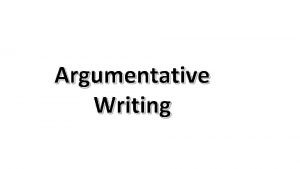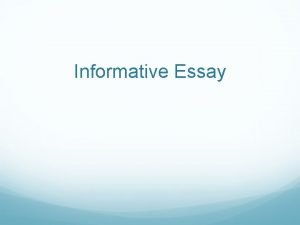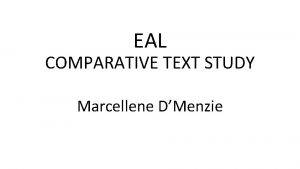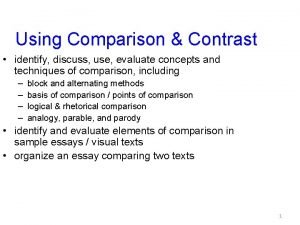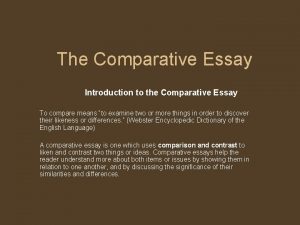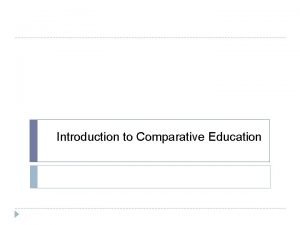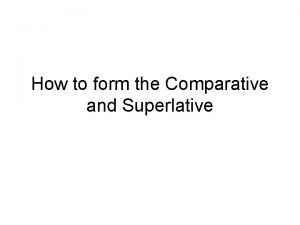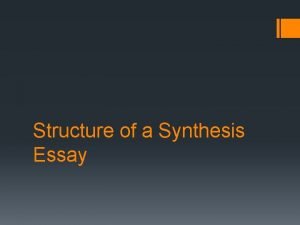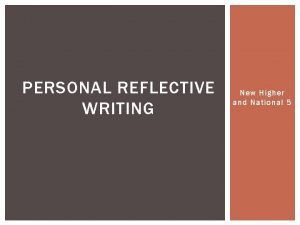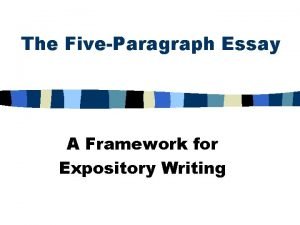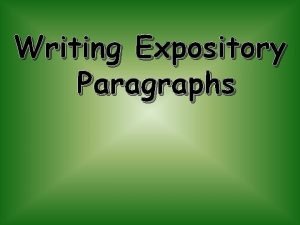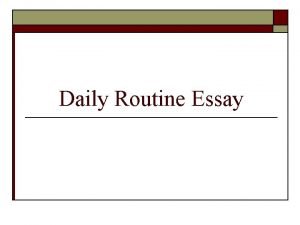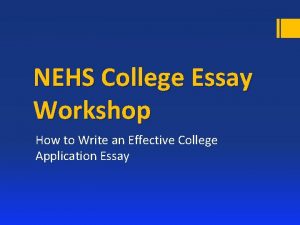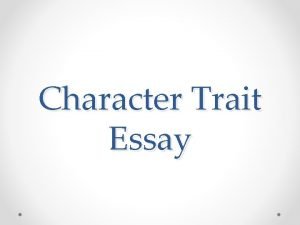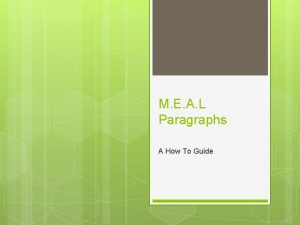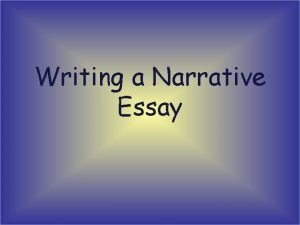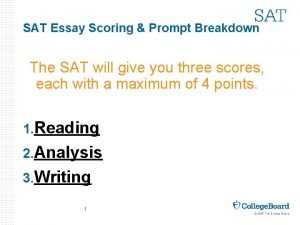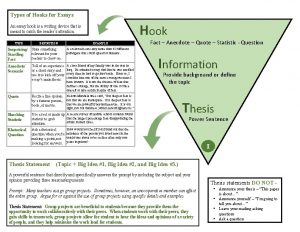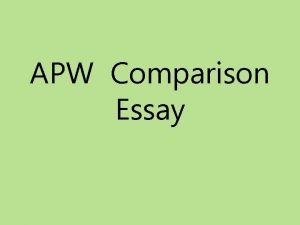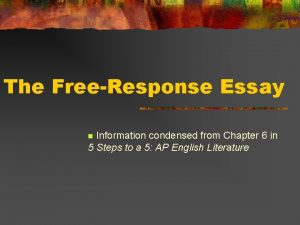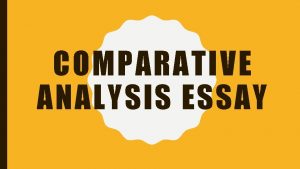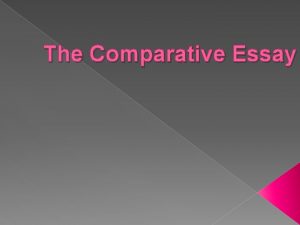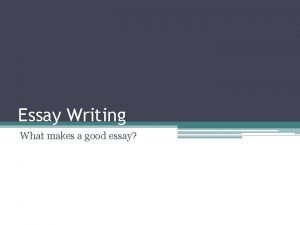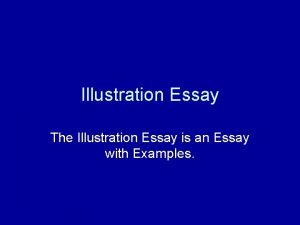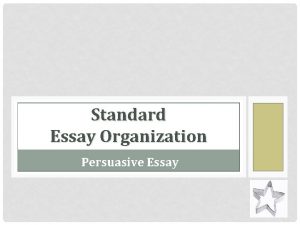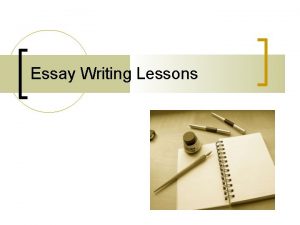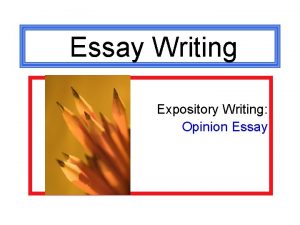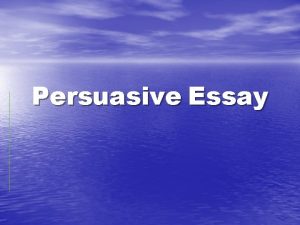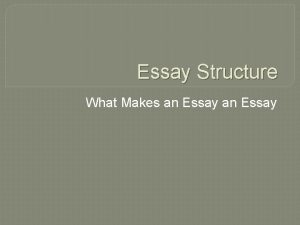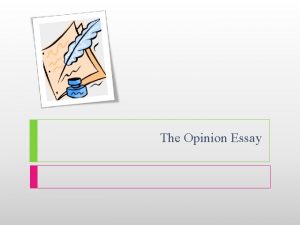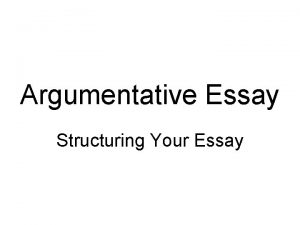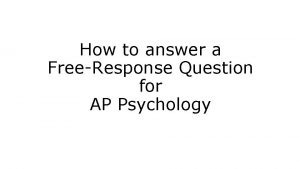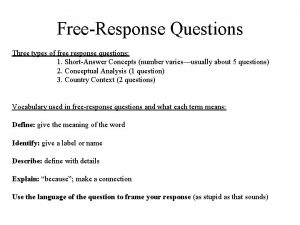FreeResponse Comparative Essay Comparative is 1 of 3





























- Slides: 29

Free-Response: Comparative Essay Comparative is 1 of 3 different styles of essay. Simplest in terms of structure but, of course, difficulty varies with the prompt. ★ Introduction with THESIS ★ As many direct comparisons as you can ★ A conclusion paragraph Must describe similarities & differences & analyze why at least one similarity/difference exists Similarities: Since, Moreover, Similarly, As well as, Still, Likewise, Also, furthermore Differences: But, However, Although, Though, In contrast, Alternatively, On the other hand, To the contrary

Solid Thesis - answers the prompt. Each body paragraph should contain. . . TASC: Topic Sentence (direct comparison) Analysis as to why the similarity/difference existed Support with 3 pieces of evidence Connect it to a larger global context or theme

The THESIS How do I show analysis in thesis? A good rule to follow, or way to write it is to be sure the 2 nd sentence states: “This similarity/difference was most likely due to the fact that _____. ”

Analyze: determine their component parts; examine their nature & relationship. “The ability to break down material into its component parts so that its organizational structure may be understood. This may include the identification of parts or components, examination of the relationship between parts, recognition of hidden meanings and detection of the organizational principles or patterns involved. ”

Analyze: determine their component parts; examine their nature & relationship. Depending on what is being analyzed: Historical actors: events, processes, institutions, ideas, etc. Examination of multiple causation which looks at cause & effect relationships Evidence determining the significance and reliability of various perspectives like when point of view is analyzed. Interpretations of what happened. Comparing & contrasting changing versions of developments or theories. Underlying structures: Determining how all the processes, institutions, ideas, events, actors, motives, evidence, interpretations are connected & related & affect each other. Overall process of change and continuity: Connecting different regions & eras This is different from just explaining because of the need to look at multiple causation.

Thesis statement: Key to the entire essay. Start by brainstorming similarities or differences making sure to go beyond restating the question. A good thesis must: 1) specify the topic 2) answer the whole question asked (similarities and differences, all elements of the prompt) 3) be more specific than the question prompt (the HOW) 4) analyze the cause for differences or reason for similarities (the WHY) Use the whole introductory paragraph to bring thesis together. Structure your introductory paragraph in the following way: - Topic of the essay (who, what, where, when) - Similarities - Differences - Analysis (must refer back to similarities and differences in previous sentences)

Body Paragraphs: After introduction you must fill in the body of your essay. Each paragraph should start with an analytical topic sentence. This topic sentence must link back to & expand on your thesis & contain the essence of the comparison you are trying to make. If we label our topics of comparison A & B -and- our points of comparison 1, 2, 3: Body Paragraph I: 1 (A, B) Body Paragraph II: 2 (A, B) Body Paragraph III: 3 (A, B) This allows you to spend the most time actually making & proving your thesis. You may have more comparisons to make depending on the question. Try to make at least 3 main comparisons, but remember these are DIRECT COMPARISONS between the two topics. Within each paragraph attempt to create as many examples, direct comparison examples, as possible within that topic.

Conclusion: This is the least important piece of the essay but is a great opportunity to gain expanded core points. Try to link the topic of the essay to the broader story of history. This is referred to as “global context” Why are you conclusions important? What does it show us about history as a whole? Has the student related comparisons to a larger global context? Global context may be on a regional level OR on a country level.

Thesis statement: this is the key to the entire essay. Start by brainstorming similarities or differences making sure to go beyond restating the question. Remember a good thesis must: 1) specify the topic 2) answer the whole question asked (similarities and differences, all elements of the prompt) 3) be more specific than the question prompt (the HOW) 4) analyze the cause for differences or reason for similarities (the WHY) Use the whole introductory paragraph to bring thesis together. You can structure your introductory paragraph in the following way: - Topic of the essay (who, what, where, when) - Similarities - Differences - Analysis (must refer back to similarities and differences in previous sentences) Body Paragraphs: After your introduction you must fill in the body of your essay. Each paragraph should start with an analytical topic sentence. This topic sentence must link back to and expand on your thesis and contain the essence of the comparison you are trying to make. If we label our topics of comparison A and B and our points of comparison 1, 2, 3 the best way to structure the essay is: I: 1 (A, B) II: 2 (A, B) III: 3 (A, B) This allows you to spend the most time actually making and proving your thesis. You may have more comparisons to make depending on the question. Try to make at least 3. Conclusion: This is the least important piece of the essay but is a great opportunity to gain expanded core points. Try to link the topic of the essay to the broader story of history. Why are you conclusions important? What does it show us about history as a whole?

Interesting AP Tip Grammar does not count It helps because what you do write will be taken more seriously. You seem more competent, but it doesn't count! All you have to do is. . . make your argument. Thesis may be 2 contiguous sentences Short thesis -- better than a long one Thesis that is too long will cost points

“Has acceptable thesis…” Acceptable is a SUBJECTIVE term What is NOT acceptable? ★ Restatement of the prompt into a statement rather than a question ★ Split Thesis ★ Non-continuous thesis Split Thesis Example: The prompt asks you to compare & contrast. You write a two-paragraph essay where 1 st paragraph is about comparison & 2 nd is about contrast. If you were to take the first sentence from each paragraph and put them together, you might have a decent thesis. The readers are not allowed to do that. Thesis has to be a stand alone paragraph. A non continuous thesis Example: Sentence at the beginning of 1 st paragraph & a sentence at the end of the paragraph with examples or information in between.

THESIS IS: Specific argument that answers the question. Nothing more, nothing less. Compare Luigi's Pizza & Torchy's Tacos according to cost, taste, & overall eating experience. In comparing pizzas and tacos, they are both similar and

THESIS IS: Specific argument that answers the question. Nothing more, nothing less. In comparing pizzas and tacos, they are both similar and different. DO NOT DO THIS! This is a Pizza/Taco Thesis. If you can exchange 2 things you are comparing with Pizza/Tacos & it makes the same sense as Han China & Roman Empire = Crime Against Humanity! And a very incorrect thesis statement. Han China and the Roman Empire share many similarities and differences.


SIMPLE EXAMPLE QUESTION AND THESIS Compare and contrast the Han Empire during 206 B. C. E. -220 C. E. with the Spanish empire of the sixteenth century. The specific argument here would include at least one comparison and one contrast and reference to both the empires and the time frames. Many students may write: “There were many similarities and differences between the Han Empire during 206 B. C. E-220 B. C. E. and the Spanish empire of the sixteenth century. ” Unfortunately, this is not good enough for the AP World History Test. It is too general and more or less repeats the prompt.

SIMPLE EXAMPLE QUESTION AND THESIS Compare and contrast the Han Empire during 206 B. C. E. -220 C. E. with the Spanish empire of the sixteenth century. The specific argument here would include at least one comparison and one contrast and reference to both the empires and the time frames. With a simple addition and a bit of tweaking, you can make this thesis work: “There were many similarities and differences between the Han Empire during 206 B. C. E. - 220 B. C. E. and the Spanish empire of the sixteenth century. One was land-based and the other seabased yet they both grew rich from conquest of territory outside their boundaries. ”

SIMPLE EXAMPLE QUESTION AND THESIS Compare and contrast the Han Empire during 206 B. C. E. -220 C. E. with the Spanish empire of the sixteenth century. The specific argument here would include at least one comparison and one contrast and reference to both the empires and the time frames. You can make two sentences instead of one from the second sentence: “There were many similarities and differences between the Han Empire during 206 B. C. E-220 B. C. E and the Spanish empire of the sixteenth century. One was land-based and the other sea-based. They both grew rich from conquest of territory outside their boundaries. ”

How to Write a Compare & Contrast Thesis Some crucial points in writing a clear & analytic thesis. Example Question For several hundred years the Mongols ruled over both Russia and China. After casting off Mongol domination, both areas began a process of political and cultural recovery. Compare and contrast these processes in Russia and China.

1) Note the keywords in this essay prompt: compare and contrast. This means you must write a thesis that expresses what China and Russia had in common and where they were different. In short, your thesis must address the comparison. 2) Your thesis (and essay) should stay within the parameters of the question or prompt. An essay on the Columbian exchange should not deal with the Swahili Coast of Africa. 3) Next, your thesis should state an opinion. Be bold. Do not merely restate the question or one of its assumptions. To argue a point, you must first of all have one. The following is not an acceptable thesis; it simply restates information given by the prompt: Russia and China both gained freedom from Mongol domination. 4) Your thesis should contain the categories that you will use in the essay as evidence. Do not do this: Bad The recovery of Russia and China after the Mongols had many similarities and differences. The above sentence is vague, wimpy, and is really just a restatement of an assumption in the prompt. It is a fluttering of loose ends needing to be nailed down onto concrete categories.

Better When Russia and China recovered from Mongol domination they had similar political goals but different cultural goals. This thesis is getting there. It at least declares in general categories how the paths of China and Russia were different and how they were similar after the Mongols. It has broken down (analyzed) these things into categories that lend themselves to a well defined essay. But it could be better. Note the difference between the above thesis and the one below: Best While both Russia and China built strong centralized governments after breaking free from the Mongols, Russia imitated the culture and technology of Europe while China became isolated and built upon its own foundations. Think about this thesis for a moment. It directly addresses the comparison (tells what they have in common and where they were different. ) It contains the categories (political and cultural) on which the writer will hang relevant historical facts, and the terms (foreign influence and isolationism) on which the comparisons will be made. These categories will form the paragraphs of the essay. This thesis is a verbal engine sufficient to drive the type of essays that could generate an 8 or a 9 on your APWH test, providing you accomplish the other thesis requirements.

Comparative Structure for Essay I. Introduction: Thesis & Roadmap II. Body of Essay (Each paragraph should include): A. 1 st Sentence for each body paragraph should be a comparative (a direct comparison sentence) B. 2 nd sentence then explains/analysis the direct comparison in the first sentence C. Then subsequent sentences in the paragraph should provide at least 2 info statements/evidence in each paragraph. V. Conclusion

Keep in Mind: * thesis can only be counted as thesis and not also as a direct comparison * use linking comparative words such as “whereas” to help set up direct comparisons * if in the comparative question there is a parenthetical qualifier such as (political, economic, cultural), it is not required that evidence is given for each. This parenthetical qualifier helps students think about what to write. Thesis Statement Construction A thesis statement must Fully address the question asked (not the one you'd prefer to answer) Take a position in answering the question asked Provide organization categories to support your position (these categories will be the subject of the topic sentences in the main body paragraphs)

Example: "Compare and contrast methods of political control of the Han dynasty and the Roman Empire. " 1 st Paragraph - Show you understand the prompt. Answer the prompt briefly with a thesis statement. Example: "Both the Han dynasty and the Roman Empire were bureaucratic. The central rulers all eventually became hereditary and both empires had rulers that oppressed the peasants in order to boost political control. However, the two empires differ in that the emperors had varying justifications for ruling and rose to power in different ways. " Body Paragraphs - Re-mention something from your thesis. Elaborate, analyze and explain it. Link it back to your thesis & show it is relevant/answers the prompt. Example: "The governments of Han China and the Roman Empire were dominated by a bureaucratic government in which one ruler, typically the emperor, had absolute power over the empire. The emperor made most of the executive decisions and had the final word on all government actions. This method of political control allowed the emperor to rule with an iron fist and discouraged rebellion. " Last Paragraph Restate your thesis and add a concluding remark. This is not as important as the body paragraphs.

Scoring the Comparative Essay Basic Core Points Is thesis acceptable? 1 Does the students address all parts of the question? (This is typically where the discussion of similarities and differences is scored. ) 2 Has the students addressed most parts of the question? (1) Has the student substantiated thesis with appropriate historical evidence? 2 Has the student done so partially? (1) Has the student shown at least one relevant, direct comparison (similarity and/or difference) between or among the societies? 1 Has the student analyzed at least one reason for a similarity or difference identified in a direct comparison? 1 Total 7

Expanded Core Points Does the student have a clear, analytical, and comprehensive thesis? Has the student addressed all parts of the question thoroughly: comparisons, chronology, causation, connections, themes, interactions, and content? Has the student given ample historical evidence to substantiate his or her thesis? Has the student related comparisons to a larger global context? Has the student made direct comparisons consistently between and among societies? Has the student consistently analyzed the causes and effects of relevant similarities and differences? 0 -2 Total 2

The Confusing Part about Scoring The thesis is worth one point according to all writing rubrics, BUT not getting the point for thesis actually means that you have lost more than one point. In fact, you may not score any points at all. This happens for all points in the basic core, but since thesis is the item that students miss the most, it is the most important. Essays are scored on a 0 -9 scale, but they are actually worth 20 points each. Each essay score is multiplied by 2. 22. If you miss a point for the essay, you could end up with a 6 instead of a 9. Those three points now become 6. 6 points. See, it’s complicated!

Helpful Prompt Terms: Understanding the prompt properly is key to writing a good essay. Analyze: Determine the nature and relationship of the component parts of; explain; break apart. Tell “how, ” “why” something happened. It is like cause and effect. Assess: Judge the value of character of something; appraise; evaluate. Give it a grade: Good, Bad, Average Compare: Examine for the purpose of noting similarities and differences. When the questions call for comparisons, they expect you to include differences as well. Describe: Give an account of; tell about; give a word picture Tell what it “looks like” in words.

Helpful Prompt Terms: Understanding the prompt properly is key to writing a good essay. Discuss: Talk over; write about; consider or examine by argument or from various points of view; debate; present the different sides. Give more than one way to look at something Evaluate: Give the positive and negative points; appraise; give an opinion regarding the value of; discuss the advantages and disadvantages Give it a grade: Good, Bad, Average Examine/Explain: Make clear or plain; make clear the causes or reasons; make known in detail; tell the meaning of. Illustrate: Make clear or intelligible using examples. Tell what it “looks like” in words

Helpful Prompt Terms: Understanding the prompt properly is key to writing a good essay. Interpret: Explain the meaning, make plain, present your thinking about (supported by historical evidence) Trace: Follow the course over time; or pick 3 -5 key points within the time period established to show an issue or condition changed or remained the same. Sequence to show change or continuity To What Extent: How much? Understand both what was done and what was still left to be done. In What Ways: In what ways did an event or condition relate to another? What ways are there to look at it?
 Argumentative essay vs expository essay
Argumentative essay vs expository essay Explanatory vs argumentative essay
Explanatory vs argumentative essay Whats an argumentative essay
Whats an argumentative essay Is expository essay is an informative essay
Is expository essay is an informative essay What is a comparative essay
What is a comparative essay Black diggers and longest memory comparative essay
Black diggers and longest memory comparative essay Compare and contrast essay alternating example
Compare and contrast essay alternating example How to write a comparative essay introduction
How to write a comparative essay introduction Concept and scope of comparative education
Concept and scope of comparative education Write the comparative form of the adjectives
Write the comparative form of the adjectives Causal comparative research
Causal comparative research Bing bang bongo
Bing bang bongo What is this??
What is this?? National 5 personal reflective essay examples
National 5 personal reflective essay examples Restate sentence examples
Restate sentence examples Expository writing examples
Expository writing examples Introducing a counterclaim
Introducing a counterclaim Write an essay about daily routine
Write an essay about daily routine Extended essay english b categories
Extended essay english b categories Concept application frq ap gov examples
Concept application frq ap gov examples Answer
Answer Nehs essay examples
Nehs essay examples Argumentative essay wikipedia
Argumentative essay wikipedia Character traits in literature
Character traits in literature How to write a meal paragraph
How to write a meal paragraph Purpose of narrative essay
Purpose of narrative essay Sat essay score
Sat essay score English paragraph
English paragraph Types of hooks in english
Types of hooks in english Definition of tourism
Definition of tourism


